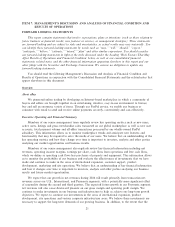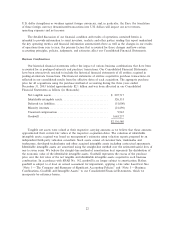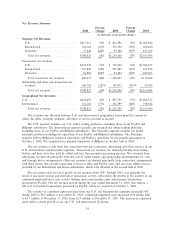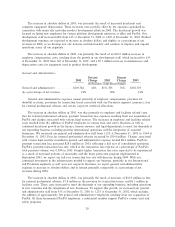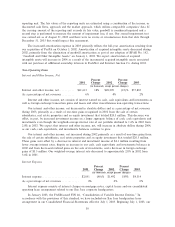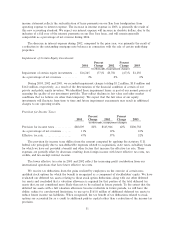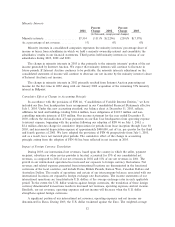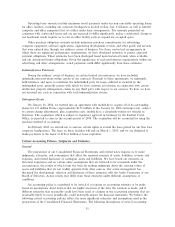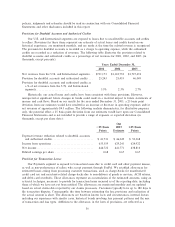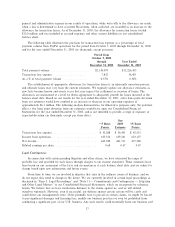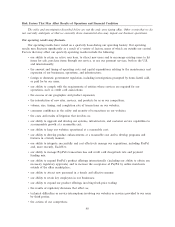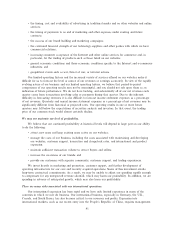eBay 2003 Annual Report Download - page 33
Download and view the complete annual report
Please find page 33 of the 2003 eBay annual report below. You can navigate through the pages in the report by either clicking on the pages listed below, or by using the keyword search tool below to find specific information within the annual report.
income statement reÖects the reclassiÑcation of lease payments on our San Jose headquarters from
operating expense to interest expense. The increase in interest expense in 2003, is primarily the result of
this new accounting standard. We expect our interest expense will increase in absolute dollars, due to the
inclusion of a full year of the interest payments on our San Jose lease, and will remain generally
comparable as a percentage of net revenue during 2004.
The decrease in interest expense during 2002, compared to the prior year, was primarily the result of
a reduction in the outstanding mortgage note balances in connection with the sale of certain underlying
properties.
Impairment of Certain Equity Investments
Percent Percent
2001 Change 2002 Change 2003
(in thousands, except percent changes)
Impairment of certain equity investments ÏÏÏ $16,245 (77)% $3,781 (67)% $1,230
As a percentage of net revenues ÏÏÏÏÏÏÏÏÏÏÏ 2% 0% 0%
During 2003, 2002 and 2001, we recorded impairment charges totaling $1.2 million, $3.8 million and
$16.2 million, respectively, as a result of the deterioration of the Ñnancial condition of certain of our
private and public equity investees. We identiÑed these impairment losses as part of our normal process of
assessing the quality of our investment portfolio. They reÖect declines in fair value and other market
conditions that we believe are other than temporary. We expect that the fair value of our equity
investments will Öuctuate from time to time and future impairment assessments may result in additional
charges to our operating results.
Provision for Income Taxes
Percent Percent
2001 Change 2002 Change 2003
(in thousands, except percent changes)
Provision for income taxes ÏÏÏÏÏÏÏÏÏÏÏÏ $80,009 82% $145,946 42% $206,738
As a percentage of net revenues ÏÏÏÏÏÏÏ 11% 12% 10%
EÅective tax rateÏÏÏÏÏÏÏÏÏÏÏÏÏÏÏÏÏÏÏÏ 47% 37% 32%
The provision for income taxes diÅers from the amount computed by applying the statutory U.S.
federal rate principally due to non-deductible expenses related to acquisitions, state taxes, subsidiary losses
for which we have not provided a beneÑt and other factors that increase the eÅective tax rate. These
expenses are partially oÅset by decreases resulting from foreign income with lower eÅective tax rates, tax
credits, and tax-exempt interest income.
The lower eÅective tax rates in 2003 and 2002 reÖect the increasing proÑt contribution from our
international operations that have lower eÅective tax rates.
We receive tax deductions from the gains realized by employees on the exercise of certain non-
qualiÑed stock options for which the beneÑt is recognized as a component of stockholders' equity. We have
evaluated our deferred tax assets relating to these stock option deductions along with our other deferred
tax assets and concluded that a valuation allowance is required for that portion of the total deferred tax
assets that are not considered more likely than not to be realized in future periods. To the extent that the
deferred tax assets with a full valuation allowance become realizable in future periods, we will have the
ability, subject to carryforward limitations, to use up to $165.8 million of additional deferred tax assets to
reduce future income tax liabilities. When recognized, the tax beneÑt of tax deductions related to stock
options are accounted for as a credit to additional paid-in capital rather than a reduction of the income tax
provision.
31


